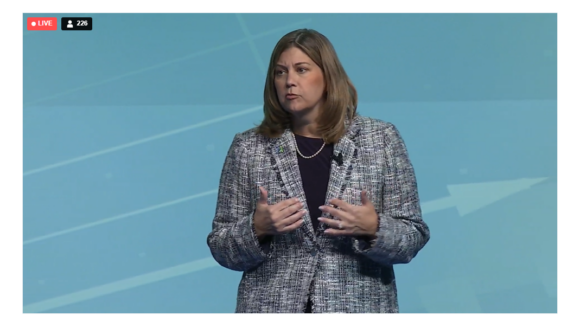While the property/casualty insurance industry overall may have seen a slight loss in profitability in 2022, workers’ compensation continues to be the most profitable line, with a “very healthy” nationwide reserve redundancy level of $17 billion.
“The system is healthy and strong,” Donna Glenn, chief actuary for the National Council on Compensation Insurance said Tuesday at the opening day of the council’s Annual Issues Symposium in Orlando.
Claims frequency declined in 2022, after a spike in 2021. But medical severity remains one of the few areas of concern for the comp industry.
“The greatest pain points we see here are medical supplies and other, which includes home health, nursing and skilled transportation costs,” Glenn said, referring to a chart of medical price pressures in the industry.
The cost of medical supplies increased 5.4% from 2021 to 2022 – more than physician services, outpatient centers, inpatient care and prescription drugs. The category, while a still-relatively small share of overall costs, can be a major driver in large claims, which appear to be on the rise. Utilization of some services, including medical imaging, is also a cost factor in rising costs.
 Medical lost-time claim severity had fallen slightly in 2021, due partly to the fact that COVID-19 claims were less costly, on average. But the severity climbed 5% in 2022, based on NCCI’s preliminary data. Over the past two decades, medical lost-time claim severity has risen a total of 65%, slightly above the U.S. personal health care price index, Glenn said.
Medical lost-time claim severity had fallen slightly in 2021, due partly to the fact that COVID-19 claims were less costly, on average. But the severity climbed 5% in 2022, based on NCCI’s preliminary data. Over the past two decades, medical lost-time claim severity has risen a total of 65%, slightly above the U.S. personal health care price index, Glenn said.
And costs may continue to rise – although outcomes will likely improve – as severely injured workers utilize new, life-saving advancements in medicine. For hemorraghing, burns, and respiratory treatments using oxygenated blood, for example, techniques and materials are now available that weren’t around a few years ago, said Dr. Michael Choo, chief medical officer at Paradigm, a workers’ comp managed care company.
“There is a cost factor, but it (the treatment) is truly amazing,” he said.
The symposium will include a deeper dive into medical trends on Wednesday, day two of the symposium.
Indemnity claim frequency returned to its pre-pandemic level and long-term trend, as the workforce emerged from the virus, and fell 4% in 2022. But indemnity claim severity, after dropping slightly in accident year 2021, jumped 6% in 2022, to $26,400.
Although the measure has tracked closely with average wages through the years, wages have risen significantly in the last three years, which will continue to put upward pressure on severity, Glenn explained.
“Despite the overall decline in frequency, it’s likely that we will continue to see some upward pressure in some industry sectors,” she noted. “But let’s remember, all of these loss drivers mean that a workplace injury has occurred. Behind every loss is perhaps the most important story – the stories about the workers and the injuries that they sustained and their recoveries and the impact to their families.”
One slightly off-note in the data this year: Investment gains on workers’ comp insurance transactions was 9% in 2022, the lowest gain in 20 years. That was not unexpected after the inflation and interest rate turbulence of 2022. The Standard & Poor’s 500 index also dropped significantly in 2022.
But overall, the workers’ compensation industry appears to be on the right track, Glenn and others at the symposium said. While just 5.5% of the property/casualty insurance industry, measured by premium, comp continues to have the lowest combined ratio, a bellwether measure of profitability. The lower the ratio, the stronger the profits, according to the NCCI, which provides ratemaking and analysis for 38 states.
Related: Massachusetts AG Settles with CVS for $6 Million on Workers’ Comp Drug Costs
The P/C industry overall posted a 102 combined ratio last year, an increase from 2021, the data show. But the comp sector clocked in at a cool 84, three points better than the year before. Loss costs continue to drop, reflecting safer workplaces and practices. Last year also was the ninth straight year for underwriting gains, industry-wide.
Net written premium climbed 3% from 2021 to 2022 for the comp industry, to $42.5 billion for private carriers, not including state funds. That was the second consecutive annual increase and came after a decline from 2019 to to 2020. Wage inflation and a tight labor market have contributed, causing payroll levels to increase 22% in the last three years.
Other key points from the opening day at the symposium: From 2019 through 2022, strains and slips-and-falls made up the majority of lost-time claims, and decreased only slightly in that time. Motor vehicle accidents declined, thanks to reduced driving during the pandemic shutdown period.
But delivery drivers saw a significant increase in injuries, mostly from strains, perhaps due to the rapid increase in new workers in that classification with less experience and training, Glenn noted.
NCCI President Bill Donnell said that the U.S. workers’ comp system is experiencing more tailwinds than headwinds, but is also facing new cost pressures, including state-level legislation. This year saw some 75 bills introduced around the country to provide better mental health benefits for some types of workers – a five-fold increase, he said.
The NCCI State of the Line presentation and data can be seen here.
Top photo: NCCI Chief Actuary Donna Glenn at the symposium Tuesday.
Topics Profit Loss Workers' Compensation
Was this article valuable?
Here are more articles you may enjoy.



 Relief But Questions on Agents’ Duties to Insureds After Florida Court Ruling
Relief But Questions on Agents’ Duties to Insureds After Florida Court Ruling  Cloudy Future for Bourbon Has Jim Beam Closing Distillery for a Year
Cloudy Future for Bourbon Has Jim Beam Closing Distillery for a Year  Litigation Funding, Other New Laws in SE States Could Impact Liability Insurance
Litigation Funding, Other New Laws in SE States Could Impact Liability Insurance  High-Net-Worth Risk Appetite Drops as Some Regions Show Stabilization
High-Net-Worth Risk Appetite Drops as Some Regions Show Stabilization 


